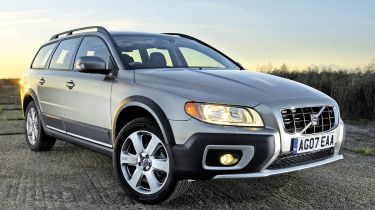Volvo XC70
Volvo's latest XC70 is as capable off-road as it is on

As with the previous generation, the new XC70 successfully bridges the gap between estate car and SUV. It proves capable on tricky surfaces, but doesn’t combine such ability with the brash off-road stance some buyers will want to avoid. It also serves as a decent estate, with a useful load space, while the cabin is comfortable and well built. The XC70 does cost around £2,000-£3,000 more than the standard V70, but it provides owners withmuch greater versatility.
It’s a simple recipe. Take a new Volvo V70, add wheelarch protection and lower-body cladding, jack up the suspension and you’ve got a sort of off-roader. Not many 4x4 buyers venture seriously into rugged terrain, so who’s to know your car’s limitations?
Unlike most new SUVs, the key to the new XC70’s appeal is that it is actually more capable in the rough than its styling suggests. Our test route took us bouncing and crunching down a steep hill of rocks and gravel with the aid of Hill Descent Control – the Land Rover invention that automatically keeps your descent speed low by using the ABS.
Once at the bottom, we turned left and scrabbled back up a similar hill. It feels like a pretty convincing off-roader! We’ve already driven the new S80-based XC70 in left-hand-drive form (Issue 961), but it’s now here in UK spec. This diesel auto is the model best suited to off-road use, thanks to strong torque and the ability to creep without needing to slip the clutch.
Used - available now

2023 Land Rover
Defender 90
8,047 milesAutomaticDiesel3.0L
Cash £61,960
2023 Mercedes
GLA
28,116 milesAutomaticDiesel2.0L
Cash £28,760
2022 BMW
X1
33,509 milesAutomaticPetrol2.0L
Cash £23,700
2022 BMW
3 Series
48,218 milesAutomaticDiesel3.0L
Cash £28,500But all new XC70s have better approach and departure angles than before, while still retaining the rugged black body mouldings. This enables them to tackle sudden terrain changes without scraping, and they can even wade through a foot of water.
Roof rails and 18-inch alloys have discreet XC70 logos to add to the SUV look. And while the basic luggage capacity offered by the big Volvo is short of some German rivals’, the estate has a useful square load area.
On the road, the XC70 feels like a taller V70. The FOUR-C adaptive damp-
ing (standard on SE Sport models) is best in Comfort mode over bumpy surfaces, but Sport is far from harsh. The third setting, Advanced, disables the adaptive technology and keeps the damping firm – although in reality, it feels barely any different from Sport.
As with the S80, both the V70 and XC70 are based on a version of Ford’s large-car platform, which also underpins the Land Rover Freelander, plus the blue oval’s S-MAX, Galaxy and, most recently, the Mondeo. So it’s no surprise that the XC70 handles reasonably, with power fed to its rear wheels when the front tyres lose grip. This helps it feel firmer and more engaging than the bigger S80 saloon.
As an alternative to the 2.4-litre 185bhp D5 turbodiesel engine, customers can opt for the powerful but thirsty 3.2-litre straight-six turbo petrol, with 238bhp. This is available only with an automatic box, and is really smooth, but doesn’t feel that fast.
It doesn’t matter which version you choose, though. As with its predecessor, the new XC70 represents a fine alternative to a fully-fledged SUV.
Rival:Audi A6 Allroad
The rugged A6 is close on price, but arguably more desirable than the new Swede. However, the Audi is less at ease over rough terrain.







